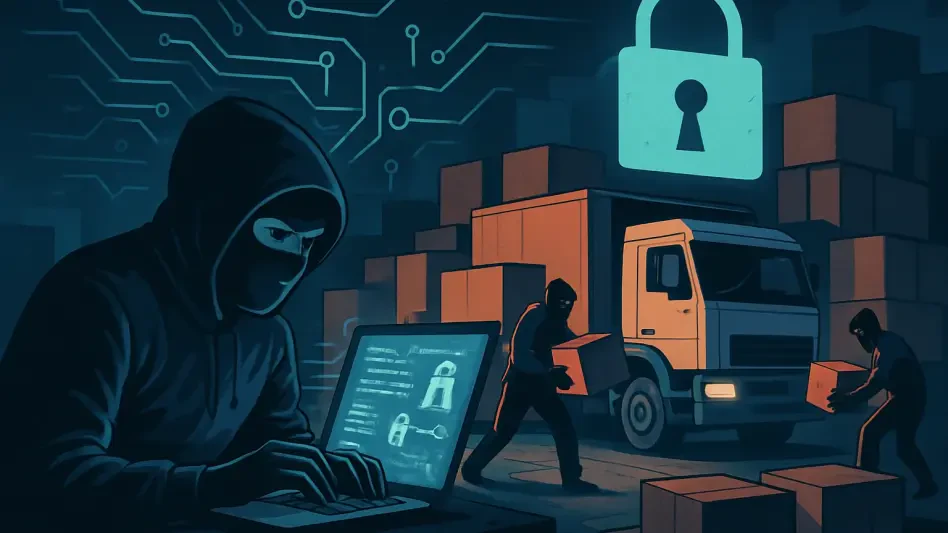In a deeply concerning development that highlights the evolving nature of crime in the digital age, a comprehensive study by a leading cybersecurity firm has exposed a troubling partnership between hackers and organized crime groups targeting cargo freight across North America. This alarming trend of cyber-enabled physical theft is wreaking havoc on the transportation and logistics industry, with billions of dollars lost annually to meticulously planned heists. As cybercriminals deploy cutting-edge techniques to breach systems and extract sensitive shipment data, their collaboration with traditional crime syndicates to execute real-world thefts of high-value goods is sending shockwaves through the sector. The findings point to a sophisticated hybrid crime model that merges digital intrusion with physical action, posing unprecedented challenges for businesses and security experts alike. This growing threat demands immediate attention and innovative solutions to safeguard critical supply chains from further disruption.
Unveiling the Cyber-Physical Crime Nexus
A pivotal aspect of the recent cybersecurity research centers on the seamless integration of cybercrime with physical theft, revealing how hackers play a crucial role in enabling cargo freight heists. By zeroing in on trucking and logistics firms, these digital intruders exploit vulnerabilities in systems to access detailed information about shipment schedules, routes, and contents. This valuable intelligence is then funneled to organized crime groups who use it to orchestrate targeted thefts of high-value cargo, often with pinpoint accuracy. Such collaboration marks a significant shift in criminal operations, creating a dual-threat environment where digital breaches directly facilitate real-world losses. The study underscores that this partnership is not a sporadic occurrence but a deliberate strategy, amplifying the impact of each heist through coordinated efforts that blend technical prowess with physical execution, leaving companies struggling to protect both their data and goods.
Beyond the mechanics of these crimes, the economic repercussions are nothing short of catastrophic for the affected industries. Estimates suggest that cargo theft, amplified by cyber intrusions, results in annual global losses of around $34 billion, a figure that illustrates the sheer scale of the problem. While North America remains the primary focus of the documented campaigns, parallel activities have been observed in freight-heavy regions such as Brazil, Mexico, and parts of Europe, indicating a pervasive international challenge. This widespread occurrence of cyber-enabled theft highlights the critical need for a unified global response, as isolated efforts are unlikely to stem the tide of such a borderless threat. The financial strain on businesses, coupled with disruptions to supply chains, places immense pressure on stakeholders to rethink security protocols and invest in measures that address both digital and physical vulnerabilities in tandem.
Dissecting the Attack Strategies and Tools
Delving into the methods employed by cybercriminals reveals a heavy reliance on social engineering as the initial breach point in their attack chain. Hackers often manipulate human trust by tampering with load boards to post fraudulent freight listings, hijacking ongoing email threads to insert malicious content, or launching deceptive email campaigns that lure employees into downloading harmful files. These tactics exploit the inherent reliance on digital communication within the logistics sector, turning routine interactions into gateways for compromise. Once a victim engages with the malicious content, the door is opened for attackers to infiltrate systems, often without raising immediate suspicion. This approach underscores the importance of employee awareness and training, as human error frequently serves as the weakest link in an otherwise fortified digital defense, allowing cybercriminals to gain a foothold with devastating consequences.
Further examination of the attack methodologies shows a strategic use of remote monitoring and management (RMM) tools, which are legitimate software repurposed for nefarious purposes. Applications such as ScreenConnect and LogMeIn Resolve are installed on compromised systems, granting hackers full remote control while evading detection by standard antivirus and network security solutions. This shift from traditional data-stealing malware to RMM tools reflects a calculated evolution in tactics, prioritizing stealth and sustained access over quick data grabs. The ability to operate covertly within a company’s infrastructure enables attackers to conduct thorough reconnaissance, harvest additional credentials, and maintain a persistent presence. Such sophistication in tool selection and deployment poses a significant hurdle for security teams, who must now contend with threats that blend seamlessly into legitimate operational workflows, complicating efforts to identify and neutralize them.
Escalating Threats and Industry Implications
The frequency and scale of these cyber-enabled attacks have surged dramatically, with nearly two dozen distinct campaigns tracked in a short span during late 2025, some involving over 1,000 targeted messages per operation. This escalation in volume, coupled with the creation of deceptive domains that mimic trusted brands or generic logistics terms, points to a highly organized and relentless threat landscape. The consistency of tactics across campaigns, alongside evidence of overlap with earlier efforts since the start of the year, suggests that these are not isolated incidents but part of a broader, sustained criminal enterprise. The persistence of these attacks indicates that hackers are continuously refining their approaches, adapting to countermeasures, and expanding their reach within the transportation sector, which remains ill-prepared for the dual digital and physical nature of the threat.
Looking at the broader implications, the partnership between hackers and organized crime groups extends far beyond immediate financial losses, disrupting entire supply chains and inflating costs for businesses and consumers alike. The staggering economic impact, compounded by the global nature of the issue, necessitates urgent action from industry leaders, policymakers, and cybersecurity professionals. Affected regions beyond North America, including South Africa and India, face similar challenges, reinforcing the call for international collaboration in sharing intelligence and best practices. As these hybrid crimes continue to evolve, the transportation industry must prioritize comprehensive security strategies that address both cyber vulnerabilities and physical safeguards. Only through a proactive, coordinated effort can the sector hope to mitigate the risks posed by this alarming convergence of digital and physical criminal activity.
Charting a Path Forward
Reflecting on the extensive findings, it becomes evident that the alliance between hackers and organized crime groups has created a formidable challenge for the transportation industry over recent months. The calculated use of social engineering to breach systems, paired with the stealthy deployment of remote access tools, has enabled a wave of cargo thefts that strike at the heart of logistics operations. The collaboration has not only resulted in billions of dollars in losses but also exposed critical weaknesses in existing security frameworks across multiple continents. Addressing this complex threat requires more than reactive measures; it demands a forward-thinking approach. Industry stakeholders need to invest in advanced cybersecurity solutions, enhance employee training to counter social engineering, and foster international partnerships to share threat intelligence. By taking these steps, the sector can build resilience against future attacks, ensuring that supply chains remain secure in an era of increasingly sophisticated hybrid crime.








